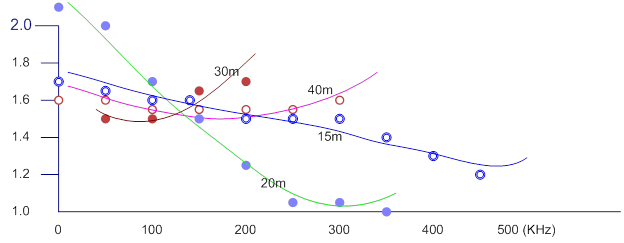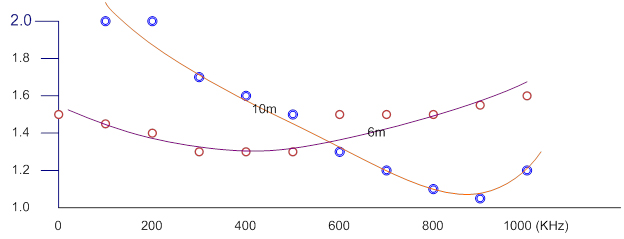Mission Viejo Special, The Multiband Vertical (#6 of 6)

Antenna Tuner
While most bands I can operate without a tuner, I do need one for 17 and 12 meter bands. My rig does have a built-in antenna tuner, but I am generally skeptical about effectiveness of in-shack tuner. This is because the length of coax cable between the tuner and the antenna tends to obscure what the real load is from the tuner point of view. The load impedance match should be done at or near the feed point of the antenna. So I have the MFJ 993BRT remote tuner at the base of the antenna. It takes up to 300 Watt PEP of power to match load impedance range of 6 to 1,600 ohm (according to MFJ manual), and it tunes relatively quickly. The DC power (12V) is fed from the shack using Bias-Tee via the coax cable. I do not trust the weather proofing of MFJ, so I cover the unit using a plastic trash bin to protect it from elements. I had this unit outside with the trash bin cover for over a year now, and it still keeps on working strong.
The signal bypasses the tuner if I turn off the unit, so I can drive kilowatt power without burning up the tuner. I am not using the kilowatt linear amplifier currently, but I do like to keep that option open.
And for those who are curious, I did tune for 60 meter and 80 meter bands successfully. I don’t know how well it works since I don’t operate there much. My performance expectation level there is not high.
Adjustment
The antenna is relatively broad-banded, so the wire length adjustments are not very critical. On the other hand, the harmonic relationships are not always exact, so some compromise is made to make all bands usable. For example, 30 meter band element is too short for 10 meter band if it is cut for 10.1MHz. So I cut it for ¾ wave of 28.5MHz. That makes the element tuned for about 9.5MHz, too long for 10m band. Ultimately, I cut the wire to resonate around 28.8MHz, and 30 meter band is still well below 2.0 limit. The feed point impedance is not the same for each band, so none of them are of perfect match. My rule of thumb is if SWR is less than 2.0, then it is usable (without a tuner). This is true for most of the modern solid state power amplifiers, and certainly true for vacuum tube amplifiers.
Below is the SWR chart for each band, except for 17m and 12m bands. Those two bands are 5/8 l long and not resonant, thus require a tuner to create the match. Thus SWR curves for those bands are meaningless.All other bands are meeting the “less than 2.0 SWR” criteria, and I am using them with the tuner turned off. The measurement is made at the feed point of the antenna, using MFJ 926 antenna analyzer.
SWR chart for 40 to 15 meter bands, less 17 and 12 meter. Measured 7/19/14

SWR chart for 10 and 6 meter bands. Measured 7/19/14

I did not make any length adjustment to the counterpoise wires. Counterpoise length should not affect the resonance frequency of the antenna, as long as UNUN at the feed point is working well.
On the Air
I have this 40meter vertical, the basis for the MV Special, since last December. This is the best darn 40 meter antenna I’ve ever used. I’ve gone through a couple of DX contests with good successes even beating out pileups sometimes.
I have this complete form of MV Special since July, or for only about a month. But as of this writing, I am very happy with the way it is working.
For the lack of any measurement objective measurement, I cannot quantify how well it is working. But both in terms of receiving and transmitting (i.e., getting call back), it compares favorably to all antennas I have had in my backyard.
Though it is not my most active band, I tried the 17meter one night (about 6:30 EUC, or 11:20PM PST), when the band was quiet and appeared to be dead, but my receiver was still hearing Hawaii beacon, so I called CQ. Sure enough, a KH6 station answered and we exchanged 579 report. Life is good.
The antenna does need an occasional (did it once in the past month) tightening of the elements, and it is important that the wires do not touch each other, but other than that, it seems fairly stable, and oblivious to the weather.
Overall, it works pretty well for a simple, low profile antenna. If you are looking for such antenna, try it.
Update... (March 9, 2015)
I've had this antenna up for 8+ months. It is going strong as everl. The Hot Rope has stretched a little, so overall, the resonant frequency went lower, especially noteable on 20 meter band, where SWR is near 1.0 at low CW band. There is no measurable data to show for the performance of the antenna, but during the past several months, I was able to contact W1AW portable stations around U.S. with relative ease. I can brag now that I scored K1N (see my blog entry "Thank you K1N...") on 40m and 20m bands. The competition was tough, so that was a real thing. Yes, I am pretty happy with the antenna so far.
| Ü | Introduction | Þ | |
| Specification | |||
| Theory | |||
| Mast, Base | Radial Plate | Boom | Elements |
| Grounding | UNUN | Tuner | Adjustment |
| On The Air | |||